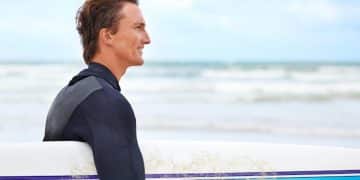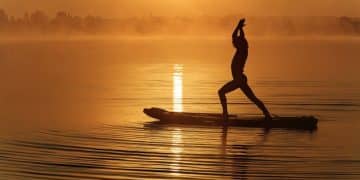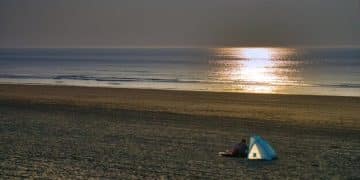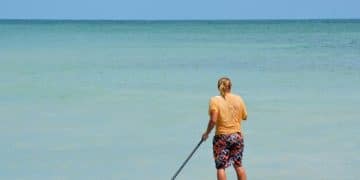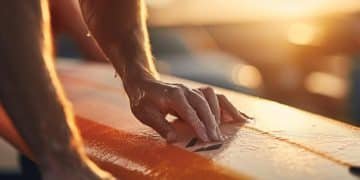Avoid These 5 Common Paddleboarding Mistakes: Save Time and Energy
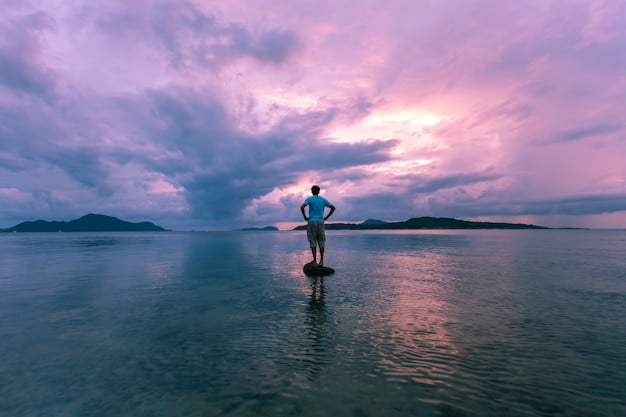
To avoid common paddleboarding mistakes that waste time and energy, focus on proper paddle technique, board positioning, understanding water conditions, selecting the right gear, and practicing fundamental balance and recovery skills before embarking on longer excursions.
Paddleboarding offers a unique blend of tranquility and adventure, allowing you to glide across the water’s surface, connect with nature, and enjoy a full-body workout. However, a smooth and enjoyable experience isn’t always guaranteed, especially for beginners or those unaware of subtle nuances. Many paddlers inadvertently make common errors that not only diminish their enjoyment but also cost them precious time and energy. This article will help you to avoid these 5 common paddleboarding mistakes that cost you time and energy on the water, ensuring your next outing is more efficient, fun, and fulfilling. By understanding and correcting these missteps, you can significantly enhance your paddleboarding prowess and truly embrace the serenity of the open water, transforming potential frustrations into effortless adventures.
Choosing the Wrong Board and Gear for the Conditions
Selecting the appropriate equipment is fundamental for an enjoyable paddleboarding experience, yet it’s a mistake often overlooked by newcomers and even some experienced paddlers. The wrong board can feel unstable, sluggish, or simply uncomfortable, turning what should be a peaceful glide into a relentless struggle. It’s not just about aesthetics; board size, shape, and even the type of fin can drastically impact your performance and efficiency on the water.
Many factors influence board choice, but perhaps the most critical are your skill level, body weight, the type of water you’ll be paddling on, and your intended activity. A vast, stable touring board designed for long distances will feel cumbersome in tight, winding rivers, just as a nimble, high-performance race board will be challenging for a beginner learning to balance in choppy conditions. Matching your equipment to your purpose and environment saves immense effort.
Understanding Board Types and Their Uses
Before you even step foot on the water, consider the diverse world of paddleboards available. All-around boards are excellent for beginners and recreational paddlers, offering a good balance of stability and maneuverability, suitable for various water conditions from calm lakes to gentle ocean swells. Touring boards, with their pointed noses and displacement hulls, slice through the water efficiently, making them ideal for long-distance paddling and exploring. Race boards are narrow and fast, requiring advanced balance and technique. Yoga-specific boards are wider and offer extra deck space for stability during poses. Solid boards generally provide better performance and glide, while inflatable SUPs (iSUPs) offer unparalleled portability and durability, making them popular for travel and those with limited storage space.
- All-around boards: Versatile, stable, great for beginners and general recreation.
- Touring boards: Longer, narrower, efficient for distance paddling.
- Race boards: High-performance, built for speed, less stable.
- Yoga SUPs: Wide, stable platforms for on-water fitness.
- Inflatable vs. Solid: Consider portability vs. raw performance.
Another crucial piece of gear often underestimated is the paddle itself. Many beginners use paddles that are too heavy or incorrectly sized, leading to rapid fatigue and inefficient strokes. A paddle should be lightweight and robust, typically made of carbon fiber or fiberglass, and adjustable to your height (usually 6-10 inches taller than you are, though this can vary based on preference and board thickness). The blade size and angle also play a role; a larger blade moves more water but requires more strength, while a smaller blade is easier to use but delivers less propulsion per stroke. An improperly sized paddle forces you to compensate with awkward body mechanics, draining your energy much faster.
Beyond the board and paddle, accessories like a leash, personal flotation device (PFD), and appropriate clothing are not just conveniences but necessities. A leash keeps your board from drifting away if you fall, a PFD is often legally required and crucial for safety, and moisture-wicking clothing prevents chafing and manages body temperature. Ignoring these seemingly minor details can quickly transform a leisurely paddle into a challenging and potentially dangerous ordeal. Being adequately equipped ensures safety and maximizes your time and energy on the water, enabling you to paddle longer and more comfortably.
Incorrect Paddle Technique and Body Positioning
Even with the perfect board and gear, an improper paddle technique can quickly turn a peaceful outing into an exhausting battle against the water. Many beginners, and even some intermediate paddlers, fall into habits that waste energy and reduce their propulsion significantly. Understanding how to hold your paddle, where to position your body, and how to execute an efficient stroke is paramount for conserving energy and maximizing your time on the water.
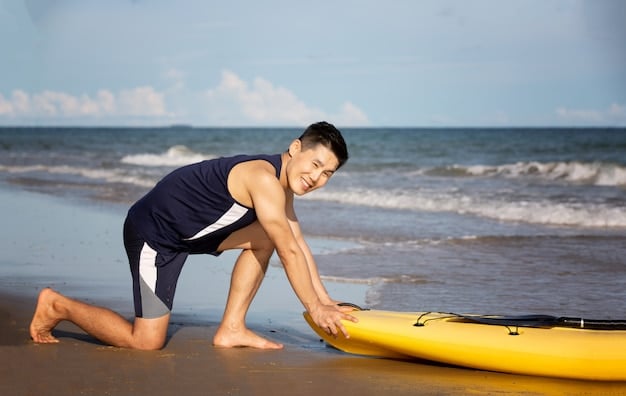
The Art of an Efficient Stroke
The paddle stroke is a complex motion that engages multiple muscle groups, not just your arms. A common mistake is using only arm strength, leading to quick fatigue in the shoulders and biceps. An effective stroke originates from your core and back muscles, using your arms primarily as levers. This technique allows for more powerful, sustained propulsion, distributing the workload across larger muscle groups. Imagine driving your paddle deep into the water, reaching forward, and then rotating your torso to pull the blade alongside the board, rather than simply tugging with your arms. This “catch, power, release” motion is the cornerstone of efficient paddleboarding.
- Reach: Extend your paddle arm forward as far as comfortable, with the blade entering the water vertically.
- Catch: Engage your core and upper back, driving the paddle deep, burying the entire blade.
- Power: Pull the paddle back towards your feet, using torso rotation and not just arm strength.
- Release: Extract the blade cleanly from the water by your heels, ready for the next stroke.
Another critical aspect often overlooked is the paddle angle. The angle of the paddle blade often faces slightly away from you at the top. This design is intentional and helps the blade “catch” more water during the power phase. Many beginners mistakenly orient the blade backward, which makes the paddle less effective and increases drag. Always ensure the “scoop” or power face of the blade is directed towards the front of the board when initiating a stroke. This subtle adjustment can dramatically improve your thrust and reduce wasted effort, allowing you to cover more distance with less exertion.
Furthermore, alternating your strokes often proves more efficient than repetitive strokes on one side. While beginners might focus on mastering a single side, experienced paddlers seamlessly switch sides every few strokes to maintain a straight course and engage different muscle groups. This alternating pattern helps prevent muscle imbalances and fatigue in one area, making for a more balanced and less strenuous paddling experience. It also prevents the board from continuously veering off course, which requires corrective strokes that further waste energy.
Mastering Body Positioning on the Board
Your stance on the board significantly impacts stability, control, and paddle efficiency. A common error is standing too far forward or backward, or adopting a rigid, wide-legged stance. Ideally, you should aim for a balanced, athletic stance with your feet shoulder-width apart, centered over the board’s handle (which is usually the balance point). Your knees should be slightly bent, allowing for small adjustments to maintain balance and absorb shocks from waves or chop. This “soft knee” approach acts like a shock absorber, rather than a stiff, upright posture that makes you vulnerable to losing balance.
Looking down at your feet or the board is another frequent mistake. This shifts your center of gravity forward and makes you less stable. Instead, keep your gaze fixed on the horizon, or at least a few feet in front of your board. This natural visual reference helps to maintain equilibrium and promotes a more confident, relaxed posture. Your core should be engaged, but not rigid, allowing for natural movement with the water. These subtle adjustments in body positioning not only enhance your stability but also enable a more powerful and efficient paddle stroke, helping to conserve energy and enjoy your time on the water.
Ignoring Water Conditions and Weather
One of the most common and energy-draining mistakes paddleboarders make is underestimating or simply ignoring the impact of water conditions and weather. What might appear to be a calm, inviting expanse of water can quickly become a formidable challenge with changing wind, currents, or tides. Ignoring these environmental factors not only makes paddling significantly harder but can also pose safety risks, turning a pleasant outing into a daunting struggle against the elements.
Reading the Water and Sky
Before launching, always take a few moments to observe your surroundings. Look for signs of wind direction and strength—are trees swaying? Are there ripples or whitecaps on the water? A strong headwind or crosswind can transform a short paddle into an arduous workout, forcing you to expend far more energy just to stay in place or move forward. Paddling against a strong wind can feel like paddling upstream, quickly leading to exhaustion and frustration.
Similarly, understanding currents and tides is crucial, particularly in coastal areas or rivers. An outgoing tide or a strong river current can carry you far from your starting point with surprising speed, making the return journey incredibly challenging. It’s often advisable to paddle against the current or wind on your way out, so you have the assistance of the elements on your return trip when you might be more tired. Knowing when high and low tide occur, as well as the direction of river flow, empowers you to plan your route intelligently and conserve your energy.
- Wind: Check forecasts; paddle upwind first if possible.
- Currents: Understand river flow or tidal movements.
- Tides: Plan routes around high and low tides in coastal areas.
- Weather forecast: Always check for sudden changes in weather, especially thunderstorms.
Beyond wind and water movement, weather changes can also catch paddlers off guard. A sunny morning can turn into a stormy afternoon with unexpected rain, lightning, or fog. These conditions not only make paddling miserable but also reduce visibility, increasing the risk of accidents. Always check the local weather forecast before you go out, and be prepared to cut your trip short if conditions deteriorate. Dressing in layers, even on warm days, allows you to adapt to changing temperatures and potential precipitation. A waterproof bag for essentials like your phone, keys, and an extra layer is also a wise precaution.
Ignoring water conditions extends to awareness of obstacles or hazards. Submerged rocks, shallow areas, or boat traffic can quickly lead to falls, equipment damage, or personal injury. Keeping a vigilant eye out for these elements helps you navigate safely and avoid unexpected energy drains from having to correct course suddenly or recover from a fall. Being proactive about understanding and respecting the environment is a hallmark of an experienced paddler, ensuring both safety and efficiency on every outing.
Not Prioritizing Balance and Core Engagement
Balance is the foundation of stand-up paddleboarding, and a lack of focus on this fundamental skill can be a major source of wasted energy and frustration. Many beginners struggle by attempting to overcompensate for instability with their arms or by maintaining a rigid, unnatural posture, both of which are common mistakes that quickly lead to fatigue. Prioritizing correct balance and engaging your core muscles correctly from the outset makes a world of difference in your efficiency and enjoyment on the water.
Finding Your Center and Engaging Your Core
The initial instinct when a board feels wobbly is often to tense up, engaging only the larger leg muscles, or to flail with the arms for stability. However, true stability on a paddleboard comes from a relaxed, responsive posture and strong core engagement. Your core muscles—abdominals, obliques, and lower back—act as your body’s natural gyroscope, allowing for subtle adjustments that maintain equilibrium. By keeping your knees slightly bent and your gaze on the horizon, you allow your body to make these micro-adjustments naturally, rather than fighting against every small movement of the board.
Think of your feet as having roots on the board, constantly feeling and responding to its movements, while your core provides the central anchor. A common mistake is to try and “muscle through” instability, which quickly exhausts the smaller, less efficient stabilizing muscles. Instead, focus on distributing your weight evenly and allowing your body to sway slightly with the board. This fluid motion, rather than a rigid stance, is key to maintaining balance with minimal effort over long periods. Practicing on calm water in a kneeling position can help you build confidence and train your core before attempting to stand up.
Practicing Stability Drills
Improving balance isn’t just about instinctively reacting; it’s a skill that can be consciously developed through practice. Simple drills can significantly enhance your stability and reduce the energy spent on simply staying upright. For example, trying to stand on one foot for a few seconds (even just lifting a heel) can activate deep stabilizing muscles. Shifting your weight slightly from side to side or fore and aft on the board helps you understand how these movements affect its stability. Incorporating paddle movements while stationary also trains your body to maintain balance while multitasking.
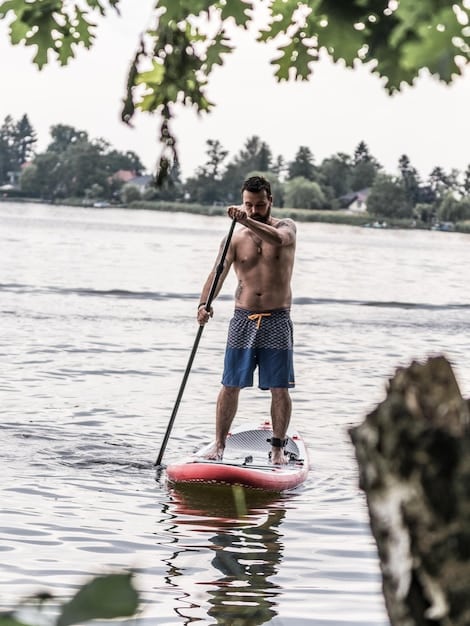
Engaging your core isn’t just for balance; it’s also fundamental to an efficient paddle stroke, as discussed earlier. A strong core allows you to transfer power from your torso through your arms to the paddle, creating a more powerful and sustained stroke. Without this engagement, you rely on less efficient arm and shoulder muscles, leading to faster fatigue. Therefore, focusing on balance and core engagement isn’t just about preventing falls; it’s about optimizing every aspect of your paddleboarding, making it less physically demanding and more enjoyable. Regularly practicing core exercises off the water, such as planks or crunches, can also translate directly to improved performance on your SUP.
Additionally, remember that falling is part of the learning process. Many paddlers expend excessive energy trying desperately to avoid a fall. While safety is always paramount, and you should recover safely, the fear of falling often makes novice paddlers rigid and less adaptable. Learning how to fall safely (away from the board and paddle) and how to remount efficiently is a vital skill. Once you overcome the fear of a tumble, you’ll find yourself more relaxed, which paradoxically improves your balance. A relaxed body can absorb bumps and shifts more effectively than a tense one, making for a much smoother and less tiring paddle. Embrace the learning curve; a few splashes are a small price to pay for mastering this rewarding sport.
Not Planning Your Route or Managing Your Energy
Many paddleboarding sessions start with enthusiasm but end in exhaustion and frustration due to a lack of planning and poor energy management. This common mistake often leads to paddlers biting off more than they can chew, misjudging distances, or simply running out of steam far from their launch point. Effective planning isn’t just about what you do on the water, but how you prepare for it, ensuring that your energy lasts as long as your desire to explore.
Strategic Route Planning for Efficiency
Before you even dip your paddle into the water, take a moment to consider your route and the factors that will influence your journey. This includes assessing the total distance you plan to cover, identifying potential rest stops, and, as previously mentioned, taking into account current, tide, and wind conditions. For instance, if you’re paddling on a river, consider the flow. If heading upstream first, you’ll be exerting more energy early on, but the return downstream will be easier. If you go downstream first, the return trip will be a greater challenge. Similarly, knowing the wind direction can help you plan an out-and-back route where you paddle against the wind on the way out, then have it at your back on the return, saving significant effort when you’re most tired.
- Distance & Duration: Estimate total time and distance; add buffer for unexpected conditions.
- Rest Stops: Identify potential places to take a break, stretch, or hydrate.
- Environmental Factors: Always factor in wind, current, and tide, planning accordingly.
- Emergency Contingency: Have a plan for unexpected weather changes or fatigue.
For longer excursions, understanding your own stamina is critical. Don’t push yourself beyond your limits, especially in unfamiliar waters. It’s better to plan a shorter, enjoyable paddle than an overly ambitious one that leaves you depleted and struggling to return. Many paddlers underestimate the physical exertion involved, particularly when battling unforeseen chop or wind. Start with shorter distances and gradually increase your range as your endurance improves. Always tell someone your planned route and estimated return time as a safety precaution.
Energy management also extends to preparing adequately for your trip. This means bringing enough water to stay hydrated, as dehydration can quickly sap your strength and focus. Snacks can provide a much-needed energy boost for longer paddles. It’s also wise to bring sunscreen, a hat, and sunglasses to protect yourself from sun exposure, which can also contribute to fatigue. These seemingly small preparations cumulatively contribute to a more comfortable and energy-efficient experience on the water, allowing you to focus on the joy of paddleboarding rather than battling fatigue or discomfort.
Pacing and Hydration
Once on the water, effective pacing is key to managing your energy. Avoid bursts of intense paddling followed by long periods of rest, especially on longer trips. Instead, aim for a consistent, moderate pace that you can maintain comfortably. This steady rhythm conserves your energy over time and prevents early exhaustion. Listen to your body; if you feel yourself getting tired, slow down, take a break by kneeling or sitting on your board, and enjoy the scenery. Many paddlers push themselves too hard too early, leaving them with little to no energy for the return journey.
Hydration is another critical component of energy management. Even on cooler days, you’re exercising and exposed to the elements, making fluid loss inevitable. Keep a water bottle easily accessible on your board and take regular sips, rather than waiting until you feel thirsty. By the time thirst sets in, you’re already partially dehydrated, which can impair performance and lead to fatigue, headaches, or even more serious issues. Proper hydration ensures your muscles function optimally and helps maintain your mental clarity, allowing you to make better decisions and enjoy your paddle without feeling drained.
Overlooking Safety Protocols and Readiness
While paddleboarding is generally a safe and accessible activity, becoming complacent about safety protocols and readiness can transform a leisurely outing into a dangerous situation. Overlooking essential safety gear, failing to check conditions, or not knowing basic rescue techniques are common mistakes that cost not only time and energy but can also put lives at risk. A prepared paddler is a confident paddler, ensuring a safer and more enjoyable experience.
Essential Safety Gear: Non-Negotiables
The single most critical piece of safety gear is a personal flotation device (PFD). In many places, wearing a PFD is legally required, and for good reason: it can save your life. Even strong swimmers can be overwhelmed by unexpected currents, cold water shock, or injury. A PFD keeps you afloat, conserving energy and allowing you to focus on self-rescue or waiting for assistance. Many modern PFDs are slim, comfortable, and designed specifically for paddle sports, so there’s little excuse not to wear one. The second essential is a leash, which connects you to your board. If you fall, especially in windy or choppy conditions, your board can drift away faster than you can swim. The board itself acts as a large flotation device, and having it tethered to you is crucial for recovery.
- Personal Flotation Device (PFD): Always wear it, or have it readily accessible; it’s often legally required.
- Leash: Crucial for keeping your board close if you fall, especially in current or wind.
- Communication Device: A waterproof phone or whistle for emergencies.
- Weather Check: Consult forecasts before and during your paddle.
- Local Regulations: Be aware of waterway rules and restrictions.
Beyond these two, a communication device—such as a cell phone in a waterproof case or a marine radio—is vital for contacting help in an emergency. A whistle can also attract attention. For longer trips or in remote areas, carrying a first-aid kit is a prudent measure. Equally important is informing someone of your float plan: where you’re going, when you expect to return, and who to contact if you don’t. This simple step can be a lifesaver if you encounter unexpected trouble.
Another often-overlooked aspect of readiness is knowing basic self-rescue techniques. What do you do if you fall? How do you remount your board efficiently? Practicing these skills in calm, shallow water can build confidence and significantly reduce the time and energy spent scrambling if an unexpected swim occurs. Knowing how to right your board, get back on, and retrieve your paddle smoothly prevents panic and conserves the energy you would otherwise expend in a frantic struggle. Understanding basic self-rescue is an empowering skill that distinguishes a prepared paddler from one merely hoping for the best.
Environmental Awareness and Contingency Planning
Safety also encompasses a broader sense of environmental awareness. This means not only checking the weather and water conditions before you launch but also continuously monitoring them while you’re out. Wind can pick up quickly, weather fronts can move in unexpectedly, and tides can change. Being attuned to these shifts allows you to make timely decisions, such as heading back to shore before conditions become too challenging. It’s always better to err on the side of caution and return early than to push through deteriorating conditions, which dramatically increases risk and effort.
Contingency planning is another critical, yet often neglected, aspect. What if your paddle breaks? What if you feel unwell? What if you encounter unexpected debris or boat traffic? Thinking through these “what ifs” and having a mentally rehearsed plan can alleviate panic and enable swift, effective action. This might involve knowing alternative landing spots, carrying a spare paddle (for longer trips), or simply having the presence of mind to signal for help. By prioritizing safety protocols and readiness, you safeguard not only your well-being but also ensure that your paddleboarding adventures remain joyous and free from unnecessary stress or preventable hazards, allowing you to fully embrace the experience without costing you time and energy.
| Key Mistake | Brief Description |
|---|---|
| 🚫 Wrong Gear Choice | Using an ill-suited board or paddle for conditions wastes immense energy and reduces enjoyment. |
| 🛶 Poor Paddle Technique | Relying only on arm strength or an inefficient stroke leads to fast fatigue and poor propulsion. |
| 💨 Ignoring Conditions | Underestimating wind, currents, or weather can make a simple paddle an exhausting and risky ordeal. |
| 🛡️ Neglecting Safety | Skipping safety gear or basic self-rescue skills creates preventable hazards and wastes energy. |
Frequently asked questions
Hold the paddle with one hand on the top of the T-grip and the other about halfway down the shaft, ensuring your elbows form a 90-degree angle when the paddle is perpendicular to the board. This wide grip maximizes leverage and allows for a more powerful stroke, engaging your core and back muscles rather than just your arms.
Wind can significantly increase the effort required for paddleboarding. A headwind will make it much harder and slower to move forward, while a crosswind can push your board off course, forcing constant corrections. Plan your route to ideally paddle against the wind on your way out, allowing a tailwind to assist your return trip when you might be more fatigued.
As a beginner, it’s highly recommended to start by kneeling on your board. This provides greater stability and a lower center of gravity, allowing you to get comfortable with paddling and balance before attempting to stand. Once you feel steady and confident on your knees, you can gradually transition to a standing position.
Consider your weight, skill level, and the type of water you’ll be paddling on. Beginners generally benefit from wider, more stable all-around boards. If you plan on long distances, a touring board might be better. Inflatables offer portability, while solid boards provide better performance. Renting different types can help you find your ideal match.
Yes, wearing a leash is crucial for safety. If you fall off your board, especially in windy conditions or currents, your board can quickly drift away from you. A leash keeps your board attached to you, ensuring you can easily recover it and use it as a flotation device, significantly reducing the energy needed for self-rescue.
Conclusion
Paddleboarding offers an incredible way to explore waterways and enjoy the outdoors, but as with any activity, a little knowledge goes a long way. By actively working to avoid these five common paddleboarding mistakes that cost you time and energy on the water—improper gear selection, faulty paddle technique, ignoring environmental conditions, neglecting balance and core engagement, and overlooking safety—you can significantly enhance your experience. These insights aren’t just about efficiency; they’re about transforming potential frustrations into effortless enjoyment, ensuring every minute on your board is spent in active relaxation rather than unnecessary struggle.
Ultimately, becoming a more confident and capable paddler is a journey of continuous learning and refinement. Each outing provides an opportunity to apply these principles, to fine-tune your technique, and to deepen your connection with the water. Embrace the process, prioritize safety, and remember that the goal is not just to paddle from point A to point B, but to savor the journey with efficiency, grace, and abundant energy. Your next paddleboarding adventure awaits—make it your best one yet by leaving these common mistakes behind.
